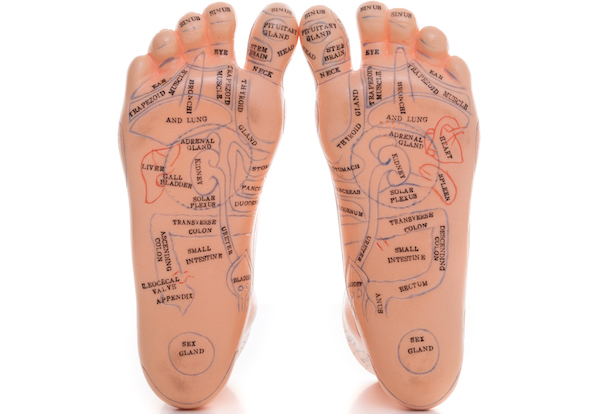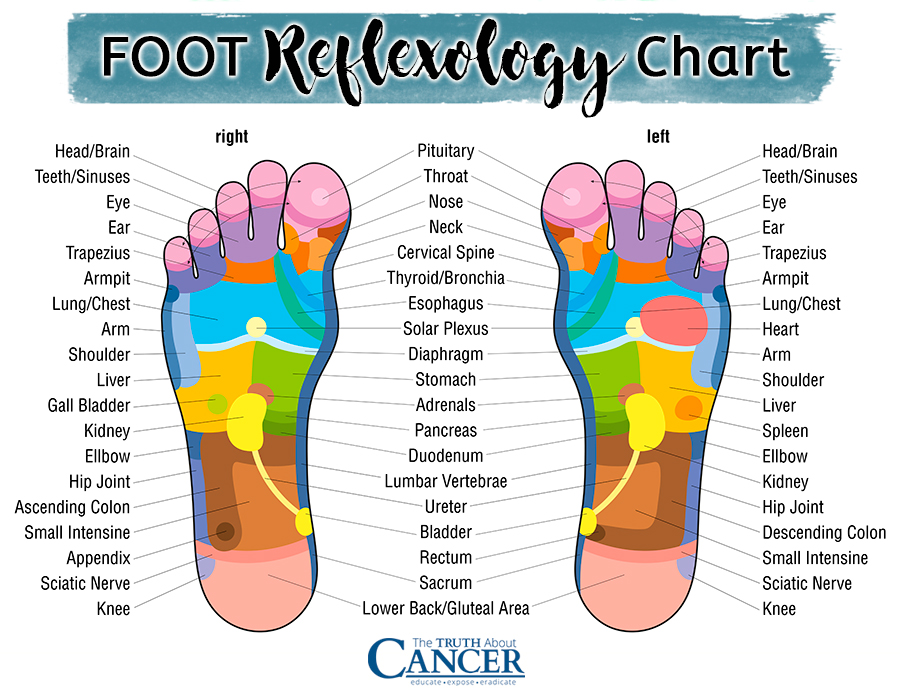A few weeks ago I wrote about the benefits of using essential oils as part of a healing massage. It’s been well established that massage therapy contributes to general good health, as well as being an excellent adjunct to both alternative and conventional cancer treatments. If, however, there are any reasons you are unable or do not wish to partake of the benefits of a body massage (back or full body), I highly recommend foot massage or reflexology treatment using essential oils as another healing modality.
Reflexology & Essential Oils
The terms “foot massage” and “reflexology” are sometimes used interchangeably. But to put these two under the same umbrella does the ancient practice of reflexology a great injustice. While reflexology does involve massage of the feet, it is a complementary therapy founded on the premise that the feet (and hands and ears) have areas of reflex and zones that correspond directly to all parts of the body.
Physically manipulating these reflexes − applying pressure to specific points using the fingers, thumb, and hand − results in stress reduction (among other chemical responses) that cause physiological changes changes in the body, and allow the body to heal itself.
Just like essential oils, reflexology has a long history in the traditional medicine practices of ancient cultures, including China, India, and Egypt. In fact, one of the first known records of reflexology is an image found in an Egyptian physician, depicting the patients having treatments of the hands and feet.
While there are several theories on why and how reflexology works, the most common belief is that it relaxes the points (or reflexes) that are connected to the specific parts of the body. This thereby improves circulation, lymphatic drainage, stimulates nerve connections, and relaxes muscles.
Stress is believed to cause up to 90% of illness. Reflexology may help to prevent and heal the damage of stress by relaxing the recipient. Paired with the reflex points, reflexology works with zones, or meridians. The belief is if you “clear” the zones, energy will flow in the body at optimum levels, and healing can follow.
Also, the endings of nerves are known to become calcified and eventually dysfunctional. Reflexology works to dissolve this calcification and revitalize the body’s nerve pathways, re-establishing communication by inducing detoxification and improved circulation.
Each foot holds in excess of 7,200 nerve endings. Stimulating these naturally has a significant impact on the body as a whole. Reflexology works to harmonize the communication of the nervous system. By applying purposeful, calming, healing touch, the body is soothed and relaxed.
In terms of clinical proofs, a significant review of 168 reflexology abstracts and studies from around the world found many notable conclusions. Many of these studies were from peer-reviewed journals in China and Korea, but all of them included information about the duration and frequency of the reflexology treatments.
Based on this review, it was found that reflexology may:
- Positively impact specific organs. MRI readings were observed to demonstrate increases in the blood flow to the intestines and kidneys, after the application of reflexology.
- Improve symptoms. The kidney functioning of patients on dialysis saw improvements. One hundred percent of cancer patients also saw significant positive changes in symptoms after a mere three reflexology treatments. Other areas of improvement included: fatigue, appetite, mood, nausea, mobility, sleep, and pain.
- Induce relaxation. After a series of treatments, certain studies demonstrated reflexology decreased both anxiety and blood pressure.
- Reduce pain experienced with certain conditions. There were 27 studies that indicated positive pain outcomes. Examples include: chest pain, kidney stones, AIDS, peripheral neuropathy of diabetes mellitus, and osteoarthritis.
- Assist in the alleviation of headache pain. In one study, after three months of reflexology, 81% of patients reported that the treatment helped or eliminated their headaches entirely. Of the same group, 19% were able to stop the OTC or prescription drugs they had previously been using to treat their pain altogether.
- Improve cardiovascular health. Reflexology has been noted to boost the health of the heart by reducing the anxiety, stress, and pain that can add stress and risk to the cardiovascular system, as well as lowering baroreceptor reflex sensitivity.
Using Reflexology for Healing
While it has many proven benefits, it’s important to remember reflexology doesn’t “heal” − the body repairs itself. If nothing else, the human body responds to touch in such a way that restoration is facilitated on all levels. Like massage and essential oils, this makes reflexology a wonderful supplement to additional conventional and alternative (natural) therapies.
There are very likely many reflexology practitioners near you, if you are keen to have a session. You can enquire through your personal network, or search online (perhaps a directory of holistic practitioners) to find one you like in your area.
In addition, or as an alternative, you can begin by trying out some techniques yourself at home. Below is a step-by-step guide for giving a basic reflexology foot massage to a loved one or even yourself using essential oils. While giving the treatment, if the person receiving the massage feels pain, simply reduce the pressure, but continue massaging gently. Over time the pain will minimize, which indicates the area is being unblocked and the corresponding organ is benefitting.
To keep the systems of a body working well, consistently, it’s best to massage a few of the major pressure points daily, using 3-4 drops of essential oils. You can apply the oils directly, or dilute them with a good organic carrier oil, such as jojoba, coconut, or olive oil.
How to Give an Essential Oil Foot Massage
Step 1: Choose your essential oil. Use a dilution or blend in conjunction with a carrier oil. Begin by massaging the center of the arch of one foot, rubbing clockwise. Over the span of a few minutes, total, gradually increase the size of your circles, and add pressure. Then switch to the other foot, trying to mirror the time and actions you performed on the first foot. In this way you create a balance between each foot as you are massaging.
Step 2: Press your knuckle into the center of the foot, then massage the area in small circles. Then switch feet. This will activate the spleen on the left foot, and the liver on the right.
Step 3: Massage the balls of the feet using your thumbs and knuckles. This reduces pressure and tension. Keep your focus on one foot for a few minutes before switching to the other for an equal time.
Step 4: Work the middle, base, and neck of the big toe to unblock control areas of the brain. Use your thumb or knuckle to press into the toe, making a circular, downward movement. You can then move on to do the same movement on each toe of the other foot, before switching feet. This will relieve stress and unblock emotions.
Step 5: Next work on the heel of the foot. Apply pressure to the bottom center, and the large bones that are on either side of the foot. This targets the prostate in men, and the reproductive organs in both men and women.
Step 6: To round off and complete the foot massage, work on the top of the feet and ankles for a few minutes on each foot. Remember, if the person feels pain at a certain zone or reflex, lessen the pressure slightly. The pain is a good indicator of where attention is needed, but go gently. Continue massage and over time the pain should recede, which indicates benefits to the organs and bodily systems.
If you want to hone in on a particular problem areas in the body, consult the “reflexology chart” image above which shows you the particular areas on the feet to rub for the corresponding organ. However, even if you don’t get the exact right spot, the essential oils will still be absorbed by the feet and find their way through the bloodstream to their target area.
Because oils are absorbed so readily through the feet, please use only the highest quality oils possible along with organic carrier oils.





















Does reflexology help, if someone has broken a foot or sprained it? Would doing reflexology help mend broken bones?
The last few months I have been massaging my husbands feet every evening. He has diabetes and finds the feeling has come back a lot and the pain has disappeared. Great article!
Love articles like this especially giving such great instructions for DIY. It’s unfortunate that you need a willing partner to do for you as hard to,do when you live alone but I might also try rolling my foot over a hard ball, like a tennis ball, to see if I can get some benefits. Thank you, much appreciated.